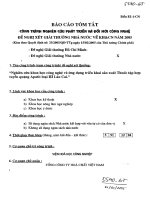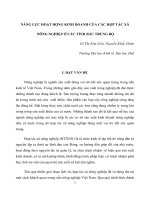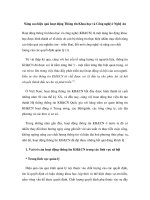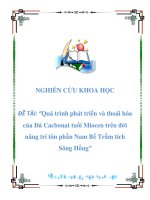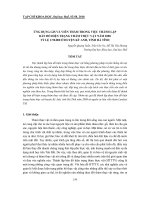Báo cáo nghiên cứu khoa học: "nâng cao quá trình lên men trong sản xuất bia nồng độ cao" ppsx
Bạn đang xem bản rút gọn của tài liệu. Xem và tải ngay bản đầy đủ của tài liệu tại đây (299.12 KB, 5 trang )
Science & Technology Development, Vol 10, No.06 - 2007
Trang 66
IMPROVEMENT OF FERMENTATION PERFORMANCE
IN HIGH GRAVITY BREWING
Le Van Viet Man, Pham Quoc Chuong
University of Technology, VNU-HCM
(Manuscript received on August 05
th
, 2005; Manuscript received on July 10
th
, 2007)
ABSTRACT: High gravity brewing is a perspective technique for increasing brewing
capacity without significant capital expenditure. In Vietnam, high gravity brewing has been
carried out in some breweries, the specific gravity of wort is up to 16
o
Plato (Pt). In this paper,
fermentation of the 16-22
o
Pt wort was examined. The obtained results showed that the higher the
specific gravity of wort, the longer the fermentation time and the higher the residual substrate
content in the green beer. The principal reason was due to high ratio of C/N content in wort.
Then some nitrogen sources were alternatively added to the 22
o
Pt wort. It was showed that the
fermentation was significantly accelerated and the alcohol content in the green beer increased.
Yeast extract was considered as a suitable nitrogen source for supplementation in high gravity
brewing. For the 22
o
Pt wort, the optimal content of supplementing yeast extract is 90mgN/litre.
1. INTRODUCTION
Many breweries throughout the world are embracing high gravity brewing as part of their
production strategy for increasing brewing capacity without significant capital expenditure. It is
one of many techniques that are being employed for process intensification of primary
fermentation and maturation in brewing (Stewart G.G. 2000). In Vietnam, up to now, high
gravity brewing has been carried out in some breweries such as Saigon brewery, Foster Tien
giang brewery… The specific gravity of wort is up to 16
o
Pt. Attempts to ferment worts with
higher specific gravity have proven to be difficult, largely because of yeast viability, slow and
incomplete fermentation. Some results show that both ethanol toxicity and high osmotic pressure
levels have been implicated as the limiting factors (Casey G.P., Magnus C.A., Ingledew W.M.,
1984).
In this paper, fermentation of the 16-22
o
Pt wort was examined for elucidating some
difficulties in high gravity brewing. Then some nitrogen sources were alternatively added to the
22
o
Pt wort for improving the fermentation performance. Finally, the optimal supplementing
nitrogen content for the high specific gravity wort was quantified.
2. MATERIALS AND METHODS
Wort: Wort was prepared from 75% malt and 25% rice by decoction method. Termamyl
120L (alpha-amylase) and Ceremix 2XL (complex: alpha-amylase, beta-glucanase and protease)
- supplied by Novo-Nordisk - were used. The specific gravity of the obtained 15
o
Pt wort was
then adjusted to 16, 18, 20 or 22
o
Pt by sucrose addition. In this research, malt was supplied by
Barrett Burston Malting Co., rice - by My tuong Co. Ltd. and sucrose - by Bourbon Co., Ltd.
(NH
4
)
2
HPO
4
and yeast extract (produced by a Chinese company) were used as supplementing
source of nitrogen.
Fermentation: A strain of Saccharomyces cerevisiae species was used. The inoculating rate
was 15 million viable cells per mL. The fermentation was carried out at 16
o
C in a 1.5L
fermenter.
TẠP CHÍ PHÁT TRIỂN KH&CN, TẬP 10, SỐ 06 - 2007
Trang 67
Analytical methods (EBC Analytica, 1987).
Specific gravity was determined by densimeter method (Anton Paar equipment). The
precision of this equipment is ± 0.01
o
Pt.
Free amino nitrogen was determined by spectrophotometric method using ninhydrin reagent.
Ethanol was analyzed by gas chromotography using flame ionisation detector (FID)
Yeast cell concentration was determined by hemocytometry using Malassez counter.
Methylene blue test was used for yeast viability evaluation.
3. RESULTS AND DISCUSSION
3.1. Fermentation of high specific gravity wort
The fermentation was carried out with four high specific gravity worts: 16, 18, 20 and 22
o
Pt.
The concentrations of free amino nitrogen in the four media were similar (196mg/L). Figure 1
shows the kinetics of specific gravity during the fermentation.
0
5
10
15
20
25
0 48 96 144 192 240 288
Time (h)
S
p
ecific
g
ravit
y
(
oPt
)
16oPt
18oPt
20oPt
22oPt
0
20
40
60
80
0 48 96 144 192 240 288
Time (h)
Yeast cell number
(
million/ mL
)
16oPt
18oPt
20oPt
22oPt
Fig 1. Kinetics of wort specific gravity Fig 2. Kinetics of yeast growth
The higher the specific gravity of wort, the longer the fermentation time. In addition, the
substrate assimilation rate of the 4 media were not the same. For 16
o
Pt and 18
o
Pt worts, it was
about 0.083
o
Pt/L.h. However, for 20
o
Pt and 22
o
Pt wort, the substrate assimilation rates were
0.073
o
Pt/L.h and 0.065
o
Pt/L.h respectively. Perhaps high osmotic pressure of high gravity wort
decreased yeast metabolic activities.
The higher the specific gravity of wort, the higher the residual substrate content in the green
beer. However this phenomenon did not affect to the quality of the final product due to beer
dilution by carbonized water after the fermentation and maturation.
The kinetics of yeast growth is visualized in figure 2. In the first 72 hours, the growth rate of
yeast in the 16
o
Pt and 18
o
Pt media was higher than that in the 20
o
Pt and 22
o
Pt media. In addition,
the maximal cell concentrations in the 16
o
Pt and 18
o
Pt worts were the highest. It is likely that
high osmotic pressure of the medium decreased yeast growth. Moreover, high sugar and low
assimilable nitrogen contents reduced the C/N ratio in high gravity wort. Some authors affirmed
that this phenomenon affects negatively to the yeast reproduction during the fermentation
(O’Connor-Cox E.S.C., Ingledew W.H. 1989).
Science & Technology Development, Vol 10, No.06 - 2007
Trang 68
With regard to ethanol formation, our results showed that the higher the specific gravity of
wort, the higher the ethanol concentration in the green beer. The ethanol formation rates in the
four 16, 18, 20 and 22
o
Pt media were 0.037, 0.037, 0.031 and 0.027 g/L.h.
3.2. Nitrogen supplementation to high gravity wort
The C/N ratio in high gravity wort is not balanced due to high sugar and low assimilable
nitrogen contents. In this experiment, three 22
o
Pt media were used. The first medium is the
control. Its free amino nitrogen content was 190mg/L. (NH
4
)
2
SO
4
and yeast extract were added
to the second and the third media respectively for supplementation of nitrogen source
(60mgN/L). Figure 3 shows the specific gravity evolution during the fermentation.
0
5
10
15
20
25
04896144192240288
Ti me (h
)
S
p
ecific
g
ravit
y
(
oPt
)
Co n t rol
(NH4)2HPO4
Yeast extract
0
2
4
6
8
10
12
0 48 96 144 192 240 288
Ti me (h
)
Ethanol
(
%v/v
)
Co nt r o l
(NH4)2HPO4
Yeast extract
Fig 3. Kinetics of specific gravity in the 22
o
Pt wort
with nitrogen addition
Fig 4. Kinetics of ethanol formation in the
22
o
Pt wort with nitrogen addition
Nitrogen addition to high specific gravity wort reduced significantly the fermentation time in
brewing. The fermentation time of medium supplemented by (NH
4
)
2
SO
4
or yeast extract was
91% or 82% respectively in comparison with that of the control sample. Therefore, yeast extract
gave better result than (NH
4
)
2
SO
4
. Decrease in fermentation time increases the fermenter
capacity and reduces the energy, labor and capital costs.
Figure 4 indicates that nitrogen supplementation to wort increased significantly the ethanol
production rate. The ethanol production rate increased 18.5% (0.032g/L.h) and 33.3%
(0.036g/L.h) in worts added by (NH
4
)
2
SO
4
and yeast extract respectively over that seen in the
control sample (0.027g/L.h). It appeared that these supplements ameliorated the metabolic
activities of yeast. The ethanol concentration in green beer from wort with nitrogen
supplementation was a little higher than that from the control medium.
3. 3. Determination of the supplemented nitrogen content
Yeast extract was chosen as a suitable nutritive source for yeast in high gravity brewing. In
this experiment, five media were used. The first one was the control sample. Its free amino
nitrogen content was 195mg/L. Different contents of yeast extract: 30, 60, 90 and 120mgN/L
was alternatively added to the four media. Figure 5 shows that increase in nitrogen content in
wort decreased the fermentation time.
TẠP CHÍ PHÁT TRIỂN KH&CN, TẬP 10, SỐ 06 - 2007
Trang 69
0
5
10
15
20
25
0 48 96 144 192 240 288
Time (h)
Specific gravity (
o
Pt)
Co nt r ol
30mgN/L
60mgN/L
90mgN/L
120mgN/L
0
2
4
6
8
10
12
0 48 96 144 192 240 288
Time (h)
Ethanol
(
%v/v
)
Co n t r ol
30mgN/L
60mgN/L
90mgN/L
120mgN/ L
Fig 5. Influence of yeast extract supplementation to
the evolution of specific gravity in the 22
o
Pt wort
Fig 6. Influence of yeast extract
supplementation to the ethanol formation in the
22
o
Pt wort
With regard to yeast growth, it was observed that the higher the nitrogen content in wort, the
higher the growth rate of yeast and the higher the cell concentration.
The kinetics of ethanol formation were seen on figure 6. If the supplemented content
increased from 30mgN/L to 90 mgN/L, the ethanol production rate increased from 11.5% to
38.5% in comparison with that in the control medium. However, the ethanol production rates
were similar in the two media supplemented by 90mgN/L and 120mgN/L. Therefore, an optimal
C/N ratio is essential for sugar transformation to ethanol in brewing. Moreover, our results
showed that nitrogen supplementation increased slightly ethanol concentration in the green beer.
4. CONCLUSION
In high gravity brewing, the fermentation time was longer in comparison with traditional
brewing. High osmotic pressure and non-optimal C/N ratio of wort decreased the growth rate,
cell concentration in the fermenting medium and metabolic activity of yeast during the
fermentation. Nitrogen supplementation to high gravity wort was a simple technique for
ameliorating the fermentation performance. Yeast extract was considered as a suitable nitrogen
source. For 22
o
Pt wort brewed from 75% malt, 25% rice and sucrose (70g/L), the optimal
content of yeast extract for supplementation was approximately 90mgN/L. In this case, the
fermentation time decreased 25% and the ethanol production rate increased 38.5% in the
comparison with the control medium without nitrogen supplementation.
Science & Technology Development, Vol 10, No.06 - 2007
Trang 70
NGHIÊN CỨU CẢI THIỆN QUÁ TRÌNH LÊN MEN NỒNG ĐỘ CAO
TRONG SẢN XUẤT BIA
Lê Văn Việt Mẫn, Phạm Quốc Chương
Trường Đại Học Bách Khoa, ĐHQG-HCM
TÓM TẮT: lên men nồng độ cao là một kỹ thuật nhiều triển vọng trong sản xuất bia vì nó
làm tăng năng suất sản xuất của các nhà máy mà không đòi hỏi nhiều chi phí đầu tư. tại việt
nam, kỹ thuật lên men nồng độ cao đã được áp dụng tại một số nhà máy sản xuấ
t bia, nồng độ
chất khô của dịch nha trước khi lên men có thể tăng đến 16
o
pt. nghiên cứu này khảo sát quá
trình lên men dịch nha có nồng độ chất khô thay đổi từ 16-22
o
pt. nếu nồng độ chất khô của dịch
nha càng cao thì thời gian lên men càng dài và hàm lượng đường sót trong bia non cũng càng
cao. nguyên nhân chính là do tỉ lệ hàm lượng các hợp chất c/n trong dịch nha quá cao. tiếp theo,
chúng tôi thử bổ sung lần lượt một số hợp chất có chứa nitơ vào dịch nha 22
o
pt. kết quả thực
nghiệm cho thấy quá trình lên men được rút ngắn và nồng độ cồn trong bia non tăng lên. chất
chiết nấm men được xem là nguồn nitơ tốt nhất để bổ sung vào dịch nha trong sản xuất bia với
kỹ thuật lên men nồng độ cao. đối với dịch nha 22
o
pt, hàm lượng chất chiết nấm men cần bổ
sung là 90mgn/lít.
REFERENCES
[1]. Analytica EBC. Brauerei und Getranke Rundschau, Zurich (1987)
[2]. Casey G.P., Magnus C.A., Ingledew W.M. High gravity brewing: effects of nutrition
on yeast composition, fermentative ability and alcohol production, Applied and
Environmental Microbiology, Vol. 48, No. 3, pp 639-646 (1984)
[3]. O’Connor-Cox E.S.C., Ingledew W.H. Wort nitrogenous sources – their use in brewing
yeast. Journal of American Society of Brewing Chemists, Vol. 47, No. 4, pp 102-108
(1989)
[4]. Stewart G.G, High gravity brewing: its influence on beer and yeast quality.
Proceedings of the Tenth International Symposium on Yeast 2000, Delft University
Press, The Netherlands, pp. 129-130 (2000)


